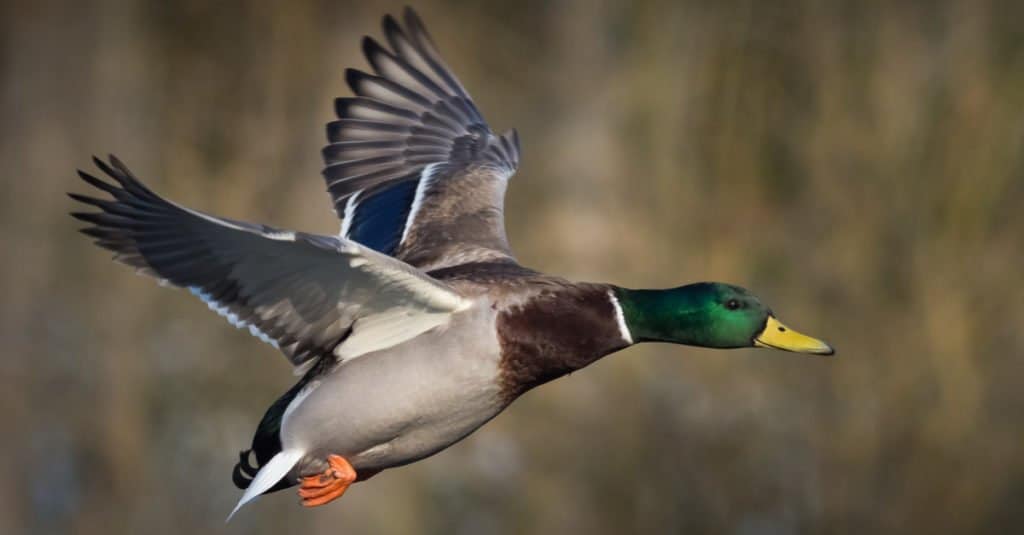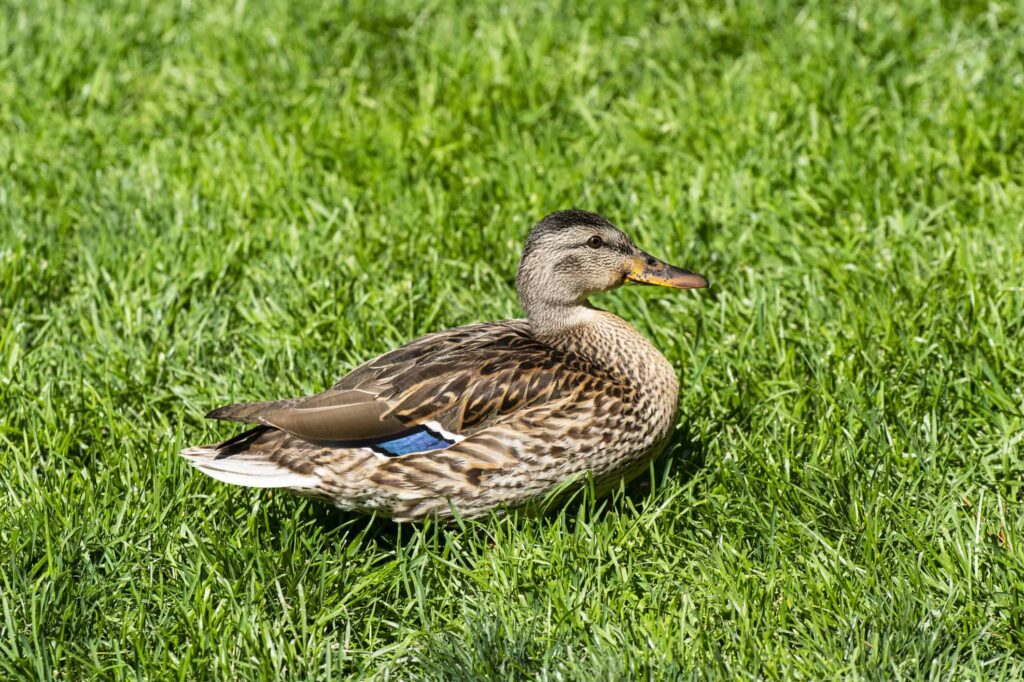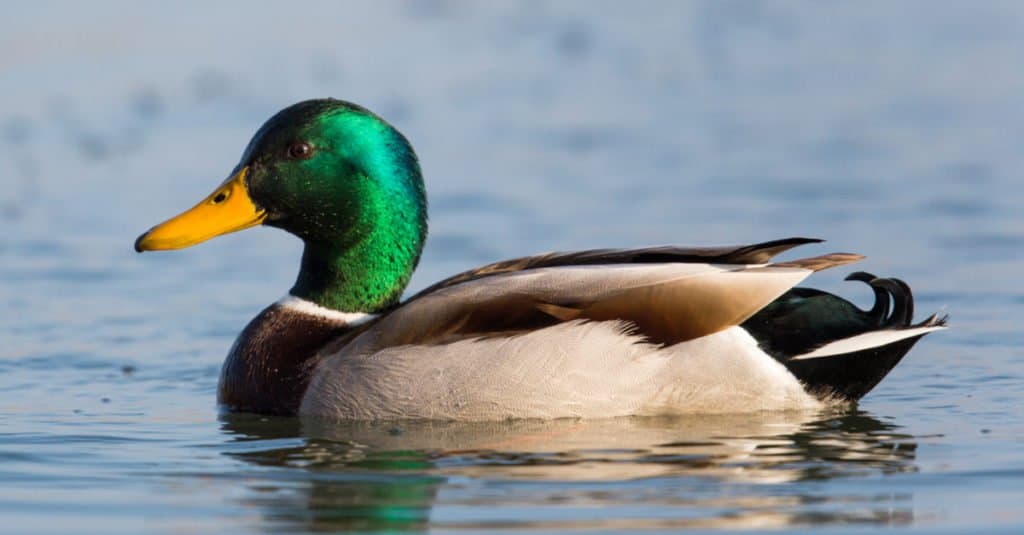Mottled ducks and mallards are both dabbling ducks that belong to the family Anatidae. All the species in this family have similar body shapes, but their feather characteristic and color distinguish them from one another.
Both species are found in brackish and freshwater wetlands, including rivers, small ponds, lakes, estuaries, ditches, and the open sea within the coastline. This article will discuss some key differences between mottled ducks and mallards to help you discern between the two.
Comparing Mottled Duck vs Mallard

| Mottled Duck | Mallard | |
|---|---|---|
| Size | 17-24 inches (43-61 cm) long and have an average weight of 2.25 pounds (1.02 kg) | 20-26 inches (50-66 cm) long, weighs 1.5-3.5 lb (0.7 to 1.6 kg) |
| Color | Shiny green-blue wing patch that is not bordered with white | Purple-blue speculum feathers with white-bordered dark tail feathers |
| Feeding | Mainly eat plants and sometimes mollusks and aquatic insects | The majority of its diet consists of gastropods, insects, crustaceans, worms, and a variety of seeds and plant matter |
| Migratory behavior | Resident all year and do not migrate | Can be resident breeders or migrants |
| Breeding habitat | They build their nests amongst vegetation, such as marsh grass and bull-rush | Nests have been found in enclosed courtyards, balconies, old crow nests, wood piles, boathouses, and hay stocks where there is a reliable food supply |
| Clutch size | 8-12 eggs | 8-13 eggs |
| Lifespan | 2-5 years | 5-10 years |
The Key Differences Between a Mottled Duck and a Mallard
The key differences between a mottled duck and a mallard are their size, color, feeding habits, migratory behavior, and clutch size.
Although they are so much alike in appearance, mottled ducks have a shiny green-blue plumage, which is not bordered with white as with the mallard. You can easily differentiate between the two species by looking at their speculum feathers, which are more prominent in flight or at rest. Their sizes also differ. Mallards are slightly larger than mottled ducks. Let’s examine all these differences in more detail to help you tell the two apart.
Mottled Duck vs Mallard: Size

Mallards measure approximately 20-26 inches and have a wingspan of 32-39 inches.
©Rostislav Stach/Shutterstock.com
Adult mottled ducks measure approximately 17-24 inches (43 to 61 cm) long from head to tail. Among standard measurements, male mottled ducks have a wingspan of about 32.7-34.3 inches (83-87 cm), while that of females is between 31.5-32.7 inches (80-83 cm). They weigh 2.25 pounds (1.02 kg) on average. Male mottled ducks weigh between 1.94-2.73 pounds (0.88-1.24 kg), while female mottled ducks weigh about 1.54-2.54 pounds (0.7-1.15 kg).
On the other hand, mallards measure approximately 20-26 inches (50-66 cm) and have a wingspan of 32-39 inches (81-98 cm). Both sexes weigh about 1.5-3.5 pounds (0.7-1.6 kg).
Mottled Duck vs Mallard: Color

Both male and female mottled ducks have a distinct shiny green-blue speculum, which lacks a white border.
©iStock.com/pichaitun
Both male and female mottled ducks have a distinct shiny green-blue speculum (wing patch), which lacks a white border, unlike in mallards. Mallard’s speculum feathers are purple-blue and edged with white. The white border is more prominent when the bird is in flight or at rest, though it sheds the feathers temporarily during the annual summer molt.
Mottled Duck vs Mallard: Feeding
Mallards are very flexible regarding their food choice; their diet varies depending on several factors, including nutrient availability and stage of the breeding cycle. Both species feed by dabbling in shallow water and grazing on land. However, mottled ducks eat plants and occasionally feed on insects and mollusks.
Mallards’ diet consists mainly of worms, crustaceans, insects, gastropods, and different types of plant matter. In 2017, several mallards in Romania were observed hunting small migratory birds, such as black redstarts and grey wagtails. There are also some reports of mallards eating frogs.
Mottled Duck vs Mallard: Migratory Behavior

Mottled ducks are resident all year round and hardly migrate compared to mallards.
©iStock.com/passion4nature
Mottled ducks are resident all year round and hardly migrate compared to mallards. The mottled duck is one of the only dabbling ducks in the United States that is non-migratory. Mallards are usually referred to as residents or medium-distance migrants. Mallards occur year-round across most parts of the United States.
Most mallards that breed across Canada and Alaska leave in the fall for wintering sites in northern Mexico and the southern region of the United States, traveling along popular migration flyways.
Mottled Duck vs Mallard: Breeding Habitat
Mottled ducks prefer breeding in coastal marshes. Both sexes fly low over vegetation in search of a suitable nesting site. Females select the best location, which is usually not far from water, often at the base of a bull-rush or marsh grass. Mottled ducks build their nests on the ground or vegetation less than 3 feet from ground level. The nest is a circular, bowl-shaped depression beneath dense overhanging vegetation.
Mallards also nest on the ground near water sources. However, they exhibit more flexible nesting habits. They may also nest in agricultural fields or utilize artificial structures in urban areas. Occasionally, mallards place their nests on floating mats of vegetation or weave them into plant stems that rise out of the water.
Mottled Duck vs Mallard: Clutch Size

Female mallards lay between 8–13 creamy-white to greenish-buff eggs per clutch.
©Pascal Halder/Shutterstock.com
Mottled ducks raise one brood each year. Female mottled ducks lay between 8–12 eggs per clutch. The eggs are creamy and greenish-white and are incubated for about 25 to 27 days. The ducklings are moved to water within 24 to 48 hours and can fly at 60 to 70 days of age.
Mallards raise one to two broods each year. Female mallards lay between 8–13 creamy-white to greenish-buff eggs per clutch. Incubation begins when the clutch is nearly complete. The incubation period lasts roughly 27 to 28 days, and ducklings can fly at 50 to 60 days of age.
Mottled Duck vs Mallard: Life Span
Mallards have an average lifespan of 5–10 years in the wild, but that’s just a static record; your mallard may live more than ten years. Mottled ducks live for 2–5 years in the wild. The oldest reported mottled duck was at least 13 years, seven months old when it was shot in Florida.
The photo featured at the top of this post is © Robert Adami/Shutterstock.com
Thank you for reading! Have some feedback for us? Contact the AZ Animals editorial team.






